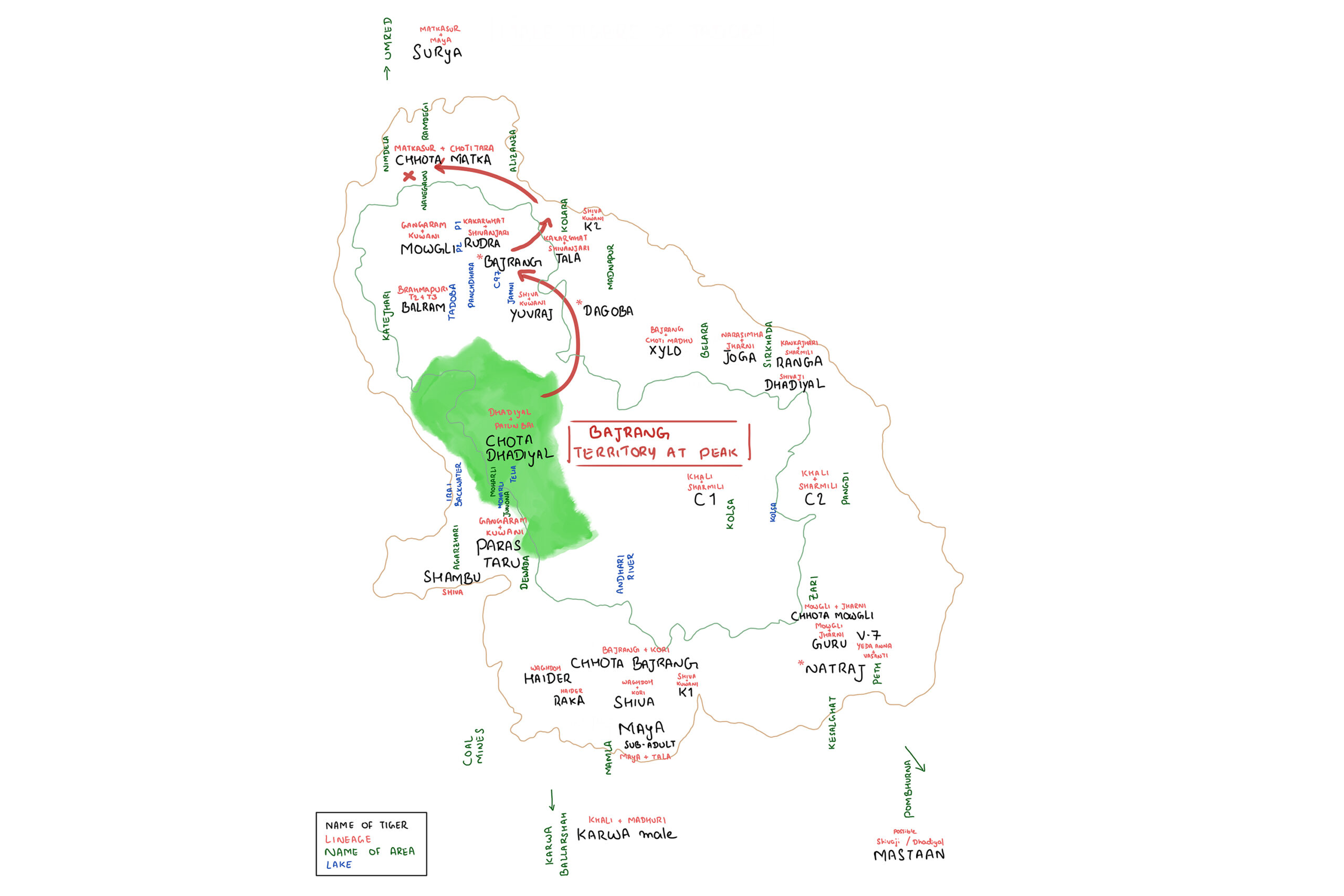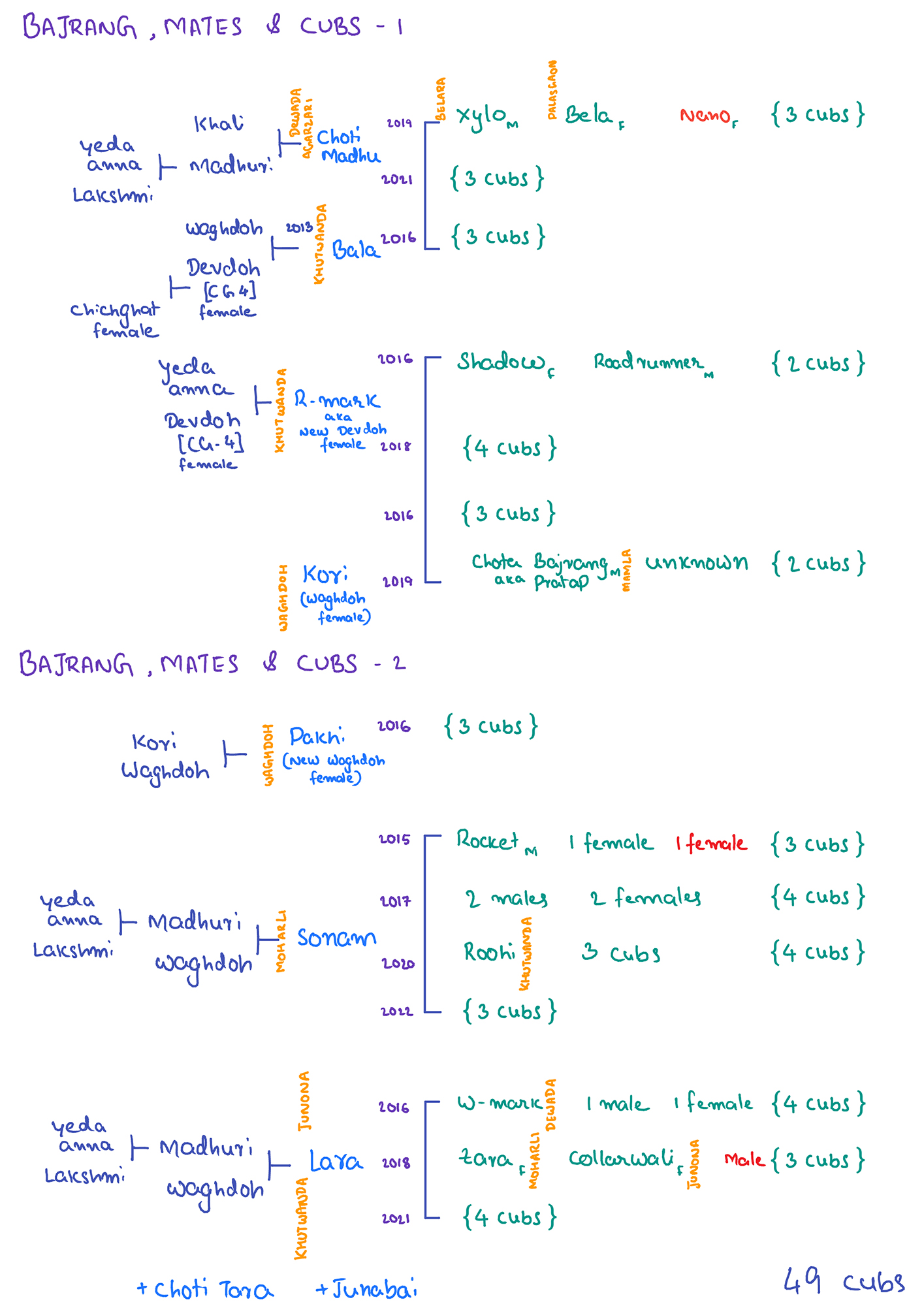Bajrang, the great
This is not just the story of Bajrang. His reign was so long that the story intertwines elements of tiger behavior, biology and biome.
Forged in the kiln of ambition, greed, power and control is a tiger that went on to become an emperor in the truest sense – dominating an extensive territory, reigning over regnant queens, and ruling interminably. His desire was like hunger; it obeys no laws, but its appetite. He continued to expand his territory till he was dethroned by younger tigers, but he had already carved the biggest territory of any tiger, ever, from Tadoba Andhari Tiger Reserve.
Bajrang from Tadoba was the stuff of a legend. Robustly built, with burly shoulders, forelimbs and a sinewy skull, Bajrang is the true exemplification of built-like-a-tank. Ironically, the name Bajrang is an epithet for the mythological Hindu god, Hanuman, and is derived from the word ‘vajra’ or the celestial weapon of Indra; which means as strong as the ‘vajra’ weapon.
Bajrang was first seen in the summer of 2014 at the Panderpauni-2 waterhole of Tadoba range. Three dominant males – Saturn (Namdeo), Gabbar (Leopard-face) and Tyson (Katezhari male) have turned the Panderpauni waterholes and encompassing territory into a bloody battlefield. A young Bajrang couldn’t settle in that territory, and thus moved to Moharli range, southwards. He was then known as Bajrang or Bajirao (till the former name caught fancy).
The forest of Tadoba is unusually hot for a multitude of reasons that include the geographical location and topographical features. The open cast coal mines in the surrounding areas absorb heat easily and release it slowly by the night. So, the average temperatures soar. The nearby Chandrapur Super Thermal Power Station (CSTPS) burns an average of 45000 metric tons of coal per day releasing particulate matter and carbon dioxide into the atmosphere which trap the sun’s heat, thereby increasing the surface temperature. In fact, the temperatures in this area have increased by around 4 °C over the past few decades; whilst the increase in other parts has been less than 1 °C. In recent times, this area has been listed as one of the hottest places on Earth.
Receiving only rain for 3 months, at times scanty, water remains a scarce resource, especially in the dry season. However, the Moharli range has a few fresh-water lakes and 2 rivers meandering through the forest area, around which wildlife is concentrated.
Naturally-formed lakes are not only the sources of water but also have their banks laced with mosses, algae, weeds and fresh sprouting grass, which become a chomping ground for ruminants such as the deer. Deer naturally attract tigers, but tigers cannot hunt deer in open grounds; a tiger cannot outrun a deer. The tall reed grasses overlooking the perennial Telia lake encompassed by dense trees provide the cover for a lurking predator like the tiger. This is the perfect ambush hunting ground.
Tigers are not spread uniformly in a forest. They tend to settle (or spend more time) around the water bodies. Multiple tigers may use the same water bodies, many a times strategically avoiding one another. Dominant tigers will not tolerate other tigers’ presence. Only the strongest of the tigers can rule a fertile domain like that of Telia lake.
From the earliest known records, around 2005-06, Yeda Anna was ruling this territory. A dominant male of his time, he controlled a sizeable portion and reigned over atleast 4 tigresses. Yeda Anna was the nucleus for tigers of Moharli range – the circuit line and the devdoh line of tigers. He was challenged and dethroned in 2011 by Waghdoh, a massive tiger of unknown origin.
The mighty Wagdoh had taken over the territory, the queens and the daughters of Yeda Anna, pushing Yeda Anna from his erstwhile southern territory to the north.
There weren’t any indications of challenges during Waghdoh’s reign. His sheer bulk was sufficiently enough to strike fear in the heart of an intruding tiger.
Waghdoh was a doting father, and he spent a considerable time with his scion. He proved wrong the conventional notion that male tigers do not care for or spend time with the offspring (it is normal for male tigers to be with the cubs, sometimes even taking care of the cubs or providing food in the conspicuous absence of the mother – multiple instances from across various reserves prove this point. But Waghdoh indeed was one of the first to be observed as a caring father).
By the end of 2013, Madhuri, the reigning queen was ousted by her daughter, S-mark female who is fondly known as Sonam. Madhuri herself took over the territory from her mother Lakshmi in the same fashion, a few years ago. Madhuri moved further south, and her loyal mate Waghdoh, who sired the four telia sisters – Geeta, Lara, Sonam, and Mona, followed Madhuri, leaving behind the lush and prey-rich territory.
His romantic liaison with Madhuri and incest/kin avoidance (by 2014, Waghdoh sired many female cubs) made him forgo his territory. So, in all probability, Bajrang took over the territory of Waghdoh without a fight.
The reign of Bajrang
In July 2014, Bajrang mated with Sonam, daughter of Madhuri and Waghdoh. It was Bajrang’s first with any tigress, and that was the beginning of his chapter.
By the end of 2014, Bajrang captured Waghdoh’s favourite territory, the Waghdoh area, which incidentally became Bajrang’s favoured territory as well. This ravine-sque landscape combined with a perennial flowing stream and the cooler shade under the dense trees is a tiger’s archetypal realm.
The Waghdoh territory was then ruled by old Waghdoh female also known as Kori. Kori delivered a litter of 2 cubs in early 2014, most likely from Waghdoh, one of which remained in the territory and would go on to become Bajrang’s mate.
Despite sitting at the top of the coveted throne of Telia and Waghdoh, and ruling over two queens, Bajrang was no ordinary tiger to remain content. With no tigers to check his authority and challenge his dominance, Bajrang went on an expansion spree. In just 2 years, he amassed a huge territory ranging from Khatoda (and parts of Kolara buffer) in the north to Khutwanda in the east, Waghdoh in the west and Dewada in the south. And with these territories, he gained many queen consorts.
By 2015-16, he was reigning over Bala (Devdoh female), R-mark (new Devdoh female), Kori (Waghdoh female), Pakhi (new Waghdoh female), Sonam and Lara. He already earned the monicker – Casanova of Tadoba.

He even mated with other females such as Choti Tara when she veered into the fringes of his territory and could have possibly mated with a couple of other tigresses as well.
Bajrang had an indomitable reign, till the end of 2020, whence he was challenged by a sudden influx of younger males. By then Bajrang had already sired 40+ cubs.
He was challenged by males like Tala (at Telia lake), Taru (Agarzhari), Ambeutara (Dewada), Paras (Dewada), Chota Dhadiyal (Moharli) etc., at different points of time. It is always difficult for an ageing tiger to constantly thwart attacks by much younger males. So, he finally had to abdicate his throne by 2022.
Such was his ruthless dominance that the domain he alone ruled once, is now ruled by more than 6 males viz., Taru, Paras, Chota Dhadiyal, Pachees-bawan (25-52), Shambu and Sanju; consequently, no tiger could have as many consorts (as Bajrang had).

He sired 49 cubs in all, the most coming from Sonam and Lara, his two beloved consorts. Of late, Sonam is being challenged by Zara (Lara’s daughter from 2nd litter) and Lara had been challenged by Roohi (Sonam’s daughter from 3rd litter); both sired by Bajrang. W-mark (Lara’s daughter from 1st litter), Collarwali (Lara’s daughter from 2nd litter) and Bela (Choti Madhu’s daughter from 1st litter) have established their territories as well. Whilst on the male-front, Chota Bajrang (aka Pratap – Kori’s son from her last litter) and Xylo (Choti Madhu’s son from 1st litter) have established territories. So, his bloodline will continue to dominate the reserve, just like that of Yeda Anna and Waghdoh – the sun will never set on Bajrang’s empire.
During his long reign of 8 years, Bajrang courted with atleast 9 tigresses, and sired many male and female cubs. But he never mated with any of the female cubs, a unique scenario which surmises an important verity in natural selection – how tigers avoid inbreeding.
Sexual selection in tigers
Mate selection, as it appears, in tigers (or many animals) is not random. Apparently, tigresses are very choosy about the mates, especially because a dominant tiger with a stable reign can provide protection to the tigress and cubs from intruding males. Tigresses choose (if they are not forced by a male) mates based on parameters like consistency and frequency of scent marking etc., thus assessing the dominance and territoriality of a male. Tigresses are induced ovulators and so, multiple acts of mating alone can induce ovulation. And a tigress must be in estrus as well for ovulation to occur. It is generally assumed as mock or pseudo-mating, but the tigress has no control over her hormones or the estrus cycle. A one-off copulation might not induce pregnancy. A dominant (or a pursuant) male on the other hand would pursue the female for days, whilst mating with her umpteen times to successfully induce ovulation.
Natural and sexual selection also favour certain mating partners over others – mostly to avoid inbreeding depression. Inbreeding refers to the mating of closely related (genetically) individuals which increases the scope of deleterious gene expression in the offspring, causing defects such as infertility, compromised immunity, defective organs etc.
Inbreeding, in tigers, is avoided to benefit the fitness of the future population and it could happen via a combination of mechanisms such as male dispersal, kin recognition and avoidance, and delayed maturation.
Tiger cubs begin to live independently by around 20-24 months of age. The mother goes into estrus and will be receptive to mating. Either the mother or the father will evict the cubs.
It is a fact that male tigers move away from natal (birth) area which is called dispersal while female tigers stay in the natal area (generally) which is called philopatry. In addition to avoiding inbreeding depression female philopatry and male dispersal benefit the population by reducing transmission of genetic and other diseases, competition for resources etc.
Male cubs begin to disperse from the mother’s territory by the age of two (they attain sexual maturity by the age of four – delayed maturation). By this age, the male cubs are physically smaller to challenge an adult territorial tiger (for ex., the father). Additionally, fathers in polygynous systems will evict sons with the potential to cuckold them, as per the Oedipus hypothesis. This nullifies the possibility of a son mating with the mother or the sibling (sister).
The female cubs carve a territory from that of the mother (especially because both are morphologically similar, at the time of separation), partially or wholly; they attain sexual maturity by the age of three. Because the territory of the father still encompasses that of his mate and daughter, there is a possibility of the father mating with the daughter. But it almost never happens; and is the most intriguing part. He might continue his polygynous relationship, with other (unrelated) tigresses, though.
To take over a territory from a dominant tiger, the intruding or challenging male generally should be reaching his prime; though older dominant tigers might relinquish territories to much younger ones. A male tiger reaches sexual maturity by the age of 4. It would probably take another 2-3 years to reach a dominating age, when he could challenge a reigning king. If he overthrows the king, and mates with the queen, his daughter would reach sexual maturity at 3 years, which would mean his age would be around 8-10 years. A second litter would even slim down the chances of father mating with the daughter, as the father moves beyond his prime age.
Avoiding inbreeding comes at opportunity costs i.e., limits the numbers of potential mates. There are cases of dominant male tigers that rule for many years, and there are cases of young tigers taking over territories. So, will a father mate with the daughter, in this scenario? Though not quantifiable, there are far less cases that speak in favour.
Despite ruling for a long period, Bajrang never mated with any of his daughters. In fact, he even tolerated his own subadult sons (viz., Rocket) unlike no other.
The extent of his territory was so vast and his mates were so large in number that there was almost no local competition for resources and breeding opportunities and thus the need to find unrelated partners, possibly.
After an indomitable reign of more than 7 years, Bajrang had to find recluse in the Tadoba range, hiding from other males in plain sight. With each tiger barely having any advantage over the other, the males viz., Mowgli, Balram, Rudra, Bajrang, Yuvraj are deftly avoiding confrontations; the erstwhile territory of Matkasur, that is now being shared by these 5 tigers. As of the monsoons of 2023, he was courting Junabai in Kolara buffer area for a short while.
By early 2023, beyond his prime though, Bajrang still seems to have some fight left in him, but his olden and golden glory were never to be reinstated. Towards the end of his life, he became a wandering tiger without a territory. Chota Matka, the dominant tiger of Alizanja zone, got the best of Bajrang on 14th November 2023. A very badly mauled Bajrang seemed to have died instantly in the skirmish.
Bajrang wasn’t a warrior or a fighter. He didn’t wage wars with other tigers. But he ruled like a king. He could bring down the formidable Indian Gaur. He conquered a massive territory - the largest ever of any tiger at Tadoba. He had the most consorts and provided a stabler rule for a very long period, vouching for the safety of the cubs as a doting father. And in the process also taught us many lessons about tigers and their behavior. His legacy thus lives on with the deserving title ‘Bajrang, the great’.

